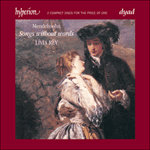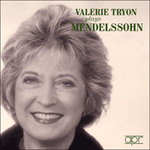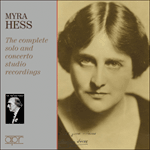Published in 1837, the third volume of
Lieder ohne Worte, Op 38, was among the first works of Mendelssohn to appear after his wedding to Cécile Jeanrenaud, daughter of a French Huguenot minister whose family had settled in Frankfurt. Like Op 30, Op 38 was dedicated to a woman, Rosa von Woringen (sister of Elise). But as in Op 30, several pieces were written for other women, including the pensive No 2, for the soprano Henriette Grabau, and the brilliantly arpeggiated No 3, for the eighteen-year-old Clara Wieck. In a special category by itself was No 6. Titled Duetto, it bore Mendelssohn’s specific instruction to highlight the two melodic voices throughout. Alternating in the soprano and tenor and then joining together, the two voices represented the composer and his fiancée, as he at once penned an intimate love song, but also drew on a tradition extending back to Weber’s
Aufforderung zum Tanz (‘Invitation to the Dance’) and Mozart’s duet ‘Là ci darem la mano’ from
Don Giovanni. Of the other
Lieder, No 4, framed by a short, improvisatory prelude and postlude, is in a homophonic style resembling a part-song. The more extended No 5, in a compound metre and propelled by agitated syncopations, perhaps suggests a ballad reminiscent of Schubert’s
Erlkönig, performed by Mendelssohn with Henriette Grabau in Leipzig in March 1837, only a month before he composed the piano piece.
from notes by R Larry Todd © 2014
Paru en 1837, le troisième volume de
Lieder ohne Worte, op.38 fut parmi les premières œuvres publiées après le mariage de Mendelssohn avec Cécile Jeanrenaud, fille d’un pasteur huguenot dont la famille s’était installée à Francfort. Comme l’op.30, cet op.38 fut dédié à une femme, Rosa von Woringen (la sœur d’Elise). Comme l’op.30 aussi, il comporte plusieurs pièces écrites pour d’autres femmes, notamment la pensive nº 2 (pour la soprano Henriette Grabau) et la nº 3, brillamment arpégée (pour Clara Wieck, alors âgée de dix-huit ans). La nº 6 forme une catégorie à part. Intitulée Duetto, elle enjoint de rehausser de bout en bout les deux voix mélodiques qui alternent au soprano et au ténor avant de se rejoindre, symbolisant le compositeur et sa fiancée: chant d’amour intime, cette pièce ne s’en appuie pas moins sur une tradition remontant à l’
Aufforderung zum Tanz («Invitation à la valse») de Weber et au duo «Là ci darem la mano» du
Don Giovanni mozartien. Le lied nº 4, cerné par un court prélude à l’improvisade et par un postlude, adopte un style homophonique, à la manière d’un chant à plusieurs voix. La pièce nº 5, plus étendue et dans une mesure composée, est propulsée par des syncopes agitées et évoque peut-être une ballade rappelant l’
Erlkönig schubertien que Mendelssohn joua à Leipzig, avec Henriette Grabau, en mars 1837, un mois seulement avant d’écrire cette page.
extrait des notes rédigées par R Larry Todd © 2014
Français: Hypérion
Der dritte Band der
Lieder ohne Worte, op. 38, wurde 1837 herausgegeben und gehört zu den ersten Werken Mendelssohns, die nach seiner Vermählung mit Cécile Jeanrenaud—die Tochter eines hugenottischen Predigers, dessen Familie sich in Frankfurt niedergelassen hatte—erschienen. Ebenso wie op. 30 war auch op. 38 einer Frau gewidmet, diesmal Rosa von Woringen (die Schwester von Elise). Jedoch ebenfalls wie in op. 30 waren auch hier mehrere Werke für andere Frauen entstanden, so etwa das nachdenkliche zweite Stück, das der Sopranistin Henriette Grabau zugeeignet war, und das brillant arpeggierte dritte Stück, welches für die 18-jährige Clara Wieck komponiert worden war. Nr. 6 ist eine Klasse für sich. Es trägt den Titel Duetto sowie Mendelssohns ausdrückliche Anweisung, die beiden Melodiestimmen durchgehend deutlich hervorzuheben. Diese alternieren in Sopran- und Tenorlage und verbinden sich schließlich miteinander—hiermit werden der Komponist und seine Verlobte dargestellt, da er zugleich ein intimes Liebeslied niederschrieb, sich jedoch ebenfalls auf eine Tradition bezog, die bis zu Webers
Aufforderung zum Tanz und Mozarts Duett „Là ci darem la mano“ aus
Don Giovanni zurückreicht. Von den anderen Liedern steht Nr. 4, das durch ein kurzes, improvisatorisches Vor- und Nachspiel eingerahmt ist, in einem homophonen Stil, der an ein mehrstimmiges Lied erinnert. Das etwas ausgedehntere 5. Lied steht in einem Dreiertakt und wird von erregten Synkopierungen vorangetrieben; damit wird möglicherweise eine Ballade wie Schuberts
Erlkönig angedeutet, den Mendelssohn mit Henriette Grabau im März 1837 in Leipzig aufführte—und bereits einen Monat später entstand das Klavierstück.
aus dem Begleittext von R Larry Todd © 2014
Deutsch: Viola Scheffel


 Mendelssohn: Songs without words
Mendelssohn: Songs without words Mendelssohn: Valerie Tryon plays Mendelssohn
Mendelssohn: Valerie Tryon plays Mendelssohn BBC Music Magazine» More
BBC Music Magazine» More Myra Hess - The complete solo and concerto studio recordings
Myra Hess - The complete solo and concerto studio recordings
